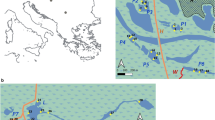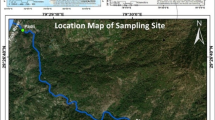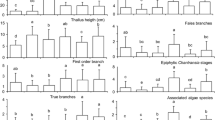Abstract
Plant communities were examined in ponds in Brittany (north-west France) and then classified into six types reflecting different trophic levels: oligotrophic, oligodystrophic, mesotrophic, meso-dystrophic, meso-eutrophic an eutrophic. In 45 of these ponds, aquatic snails were sampled in order to determine the relationship between the gastropod species richness and the water trophic levels as indicated by plant community types. The second aim of this study was to determine whether some gastropod species were characteristic of a particular trophic level. The number of plant communities in the ponds was also taken into consideration.
A trophic gradient was found along the F1 axis on the principal plane of the correspondence analyses. The species richnesses low or zero and especially the lymneid, Lymnaea glabra were close to the oligo-dystrophic and oligotrophic communities. In contrast, the highest numbers of snail species (5 and above) were found in the most eutrophic ponds where Hippeutis complanatus, Planorbis planorbis, Lymnaea stagnalis and Planorbarius corneus were particularly common. The latter species inhabited the ponds including on average the greatest number of macrophyte communities but no significant differences were found between snail species. The ponds which contained the greatest numbers of plant communities included the richest gastropod communities (7 and more) but also the poorest ones (0 or 1 species). Relationships between freshwater snails, macrophytes and trophic levels are discussed.
Similar content being viewed by others
References
Aho, J., 1966. Ecological basis of the distribution of the littoral freshwater Molluscs in the vicinity of Tampere, South Finland. Ann. zool. fenn. 3: 287–322.
Aho, J., E. Ranta & J. Vuorinen, 1981. Species composition of freshwater snail communities in lakes of southern and western Finland. Ann. zool. fenn. 18: 233–241.
Boycott, A. E., 1936. The habitats of the freshwater mollusca in Britain. J. anim. Ecol. 5: 116–186.
Braun-Blanquet, J. & J. Pavillard, 1928. Vocabulaire de sociologie végétale, 3th edn., Montpellier, 23 pp.
Brönmark, C., 1985. Freshwater molluscs: distribution patterns, predation and interactions with macrophytes. Ph. D. Dissertation, University of Lund (Sweden), 77 pp.
Brown, K. M. & D. R. De Vries, 1985. Predation and the distribution and abundance of a pulmonate pond snail. Oecologia 66: 93–99.
Browne, R. A., 1981. Lake as islands: biogeographic distribution, turnover rates and species composition in the lakes of Central New York. J. Biogeogr. 8: 75–83.
Calow, P., 1973. Gastropod associations within Malham Tarn, Yorkshire. Freshwat. Biol. 3: 521–534.
Caquet, T., 1990. Spatial distribution of four freshwater gastropod species in a ditch near Orsay, France. Hydrobiologia 203: 83–92.
Clarke, A. H., 1979. Gastropods as indicators of trophic lake stages. Nautilus 94: 138–142.
Clement, B., 1986. Typologie des zones humides de Bretagne. Recherche de bioindicateurs. Rapport Contrat Comité E.G.P.N.-S.R.E.T.I.E. & University of Rennes, 151 pp.
Clement, B. & J. Touffet, 1988. Typologie et diagnostic phytoécologique des zones humides de Bretagne. In J. M. Gehu (ed.), Colloques phytosociologiques XV. Phytosociologie et Conservation de la Nature, Strasbourg 1987. J. Cramer, Vaduz: 317–347.
Codd, G. A. & S. G. Bell, 1985. Eutrophication and toxic cyanobacteria in freshwaters. J. Wat. Pollut. Contr. 34: 225–232.
Costil, K., 1993. Contribution à l'écologie des Mollusques Gastéropodes dulcicoles armoricains; recherches bioécologiques et écophysiologiques sur deux espèces de Pulmonés Planorbidae: Planorbarius corneus (L.) et Planorbis planorbis (L.). PhD thesis, University of Rennes I, 421 pp.
Costil, K., 1994. Freshwater gastropod communities in eastern Brittany (France). J. Moll. Stud. 60: 467–471.
Dorgelo, J., 1988. Growth in a freshwater snail under laboratory conditions in relation to eutrophication. Hydrobiologia 157: 125–127.
Dussart, B., 1985. Limnologie. In Encyclopedia Universalis, Vol. 11, Encyclopedia Universalis Edition, France (Paris) S. A.: 47–56.
Dussart, B., 1985. The ecology of freshwater Molluscs in North West England in relation to water chemistry. J. moll. Stud. 42: 181–198.
Felzines, J. C., 1983. Structure des groupements et ccomplexité de la végétation aquatique et amphibie: observations sur les peuplements des étangs du Centre de la france. In J. M. Gehu (ed.), Colloques phytosociologiques X. Les végétations aquatiques et amphibies, Lille 1981. J. Cramer, Vaduz: 1–13. 5–33.
Gehu, J. M. & S. Rivas-Martinez, 1981. Notions fondamentales de phytosociologie. In H. Dierschke (ed.), Berichte der Internationalen Symposien der Internationalen Vereinigung für Vegetationkunde. Syntaxonomie J. Cramer, Vaduz:
Haynes, A. & B. J. Taylor, 1984. Food finding and food preference in Potamopyrgus jenkinsi (E. A. Smith), Prosobranchia. Arch. Hydrobiol. 100: 479–491.
Hutchinson, G. E., 1969. Eutrophication, past and present: 17–26, in: Eutrophication, causes, consequences, correctives, National Academy of Sciences, Washington, D.C.
Lamarche, A, P. Legendre & A. Chodorowski, 1982. Facteurs responsables de la distribution des gastéropodes dulcicoles dans le fleuve Saint-Laurent. Hydrobiologia 89: 61–76.
Legendre, P., D. Planas & M. J. Auclair, 1984. Succession des communautés de Gastëropodes dans deux milieux différent par leur degré d'eutrophisation. Can. J. Zool. 62: 2317–2327.
Lodge, D. M., K. M. Brown, P. Klosiewski, R. A. Stein, A. P. Covich, B. K. Leathers & C. Brönmark, 1987. Distribution of freshwater snails: spatial scale and the relative importance of physicochemical and biotic factors. Am. Malacol. Bull. 5: 73–84.
Meier-Brook, C., D. Haas, G. Winter & T. Zeller, 1987. Hydrochemical factors limiting the distribution of Bulinus truncatus. Am. Malacol. Bull. 5: 85–90.
Mouthon, J., 1981. Les Mollusques des lacs de l'Abbaye et des Rousses (Massif du Jura). Annales Scientifiques de l'Université de Besançon 4: 1–25.
Mouthon, J., 1986. Les mollusques des lacs de Tignes (Savoie): intérêt de ce groupe faunistique pour caractériser la qualité biologique des sédiments des lacs d'altitude. Ann. Limnol. 6: 161–190.
Ökland, J., 1990. Lakes and snails. Environment and Gastropoda in 1500 Norvegian lakes, ponds and rivers. Universal Book Services/Dr W. Backhuys, Oegstgeest, The Netherlands, 516 pp.
Parastergiadou, E. & D. Babalonas, 1993. The relationships between hydrochemical environmental factors and the aquatic macrophytic vegetation in stagnant and slow flowing waters, II: Evaluation of plant associations indicative value. Arch. Hydrobiol. (Suppl. 90) 4: 493–506.
Petersen, R. C., L. M. Petersen, U. Persson, A. Kullberg, A. Hargeby & A. Paarlberg, 1986. Health aspects of humic compounds in acid environments. Wat. Qual. Bull. 11: 44–49.
Pip, E., 1987. Species richness of freshwater gastropod communities in Central North America. J. moll. Stud. 53: 163–170.
Reavell, P. E., 1980. A study of the diets of some British freshwater gastropods. J. Conchol. 30: 253–271.
Russell-Hunter, W. D., 1961. Life cycle of four freshwater snails in limited populations on Loch Lomond, with a discussion of intraspecific variation. Proc. zool. Soc. Lond. 137: 135–171.
Russell-Hunter, W. D., 1978. Ecology of freshwater pulmonates. In V. Fretter & J. Peake (eds), Pulmonates, Vol. 2A. Systematics, Evolution and Ecology. Academic Press, New York: 335–384.
Spencer, W. & G. Bowes, 1990. Ecophysiology of the world's most troublesome aquatic weeds. In A. H. Pieterse & K. J. Murphy (eds), Aquatic weeds, the ecology and management of nuisance aquatic vegetation. Oxford University Press: 39–73.
Szmeja, G. & B. Clement, 1990. Comparaison de la structure et du déterminisme des Littorelletea uniflorae en Poméranie (Pologne) et en Bretagne (France). Phytocoenologia 19: 123–148.
Stat-Itcf, 1988. Logiciel de Statistiques, version 4. Institut Technique des Céréales et des Fourrages (eds), Paris.
Statview, 1988. Statview II. Abacus concepts (program). Brain Power Inc. (doc).
Sterry, P. R., J. D. Thomas & R. L. Patience, 1983. Behavioural responses of Biomphalaria glabrata (Say) to chemical factors from aquatic macrophytes including decaying Lemna paucicostata (Hegelm ex Engelm). Freshwat. Biol. 13: 465–476.
Thomas, J. D., 1987. An evaluation of the interactions between freshwater pulmonate snail hosts of human schistosomes and macrophytes. Phil. Trans. r. Soc., Lond. B 315: 75–125.
Tucker, D. S., 1958. The distribution of some freshwater invertebrates in ponds in relation to annual fluctuations in the chemical composition of the water. J. anim. Ecol. 27: 105–123.
Van Vierssen, W., M. J. Hootsmans & J. E. Vermaat, 1993. Lake Veluwe, a macrophyte-dominated system under eutrophication stress. Kluwer Academic Publishers, Dordrecht, 340 pp.
Weber, C. A., 1907. Aufbau und Vegetation der Moore Norddeutschlands. Beiblatt zu den Botanischen Jahrbuchern 90: 19–34.
Author information
Authors and Affiliations
Additional information
Laboratoire de Zoologie et d'Ecophysiologie
Rights and permissions
About this article
Cite this article
Costil, K., Clement, B. Relationship between freshwater gastropods and plant communities reflecting various trophic levels. Hydrobiologia 321, 7–16 (1996). https://doi.org/10.1007/BF00018672
Received:
Revised:
Accepted:
Issue Date:
DOI: https://doi.org/10.1007/BF00018672




